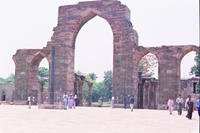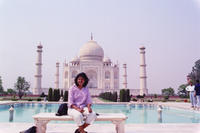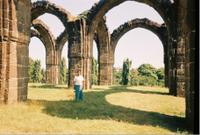Delhi
 Cow in the middle of a traffic jam, beggars in the road signals, ill mannered taxi drivers, filthy markets, railway stations, beautiful forts, mosques, palaces…all of this is a part of the experience called Delhi. Don't let your first impressions of Delhi disturb you. Go ahead and explore this city, rich with culture, architecture and human diversity, deep with history and totally addictive for all those bitten by the travel bug.
Cow in the middle of a traffic jam, beggars in the road signals, ill mannered taxi drivers, filthy markets, railway stations, beautiful forts, mosques, palaces…all of this is a part of the experience called Delhi. Don't let your first impressions of Delhi disturb you. Go ahead and explore this city, rich with culture, architecture and human diversity, deep with history and totally addictive for all those bitten by the travel bug.Delhi obviously has 2 parts…Old Delhi or Purani Delhi with the Moghul past with all its narrow labyrinth streets. It was the capital of Muslim India between the mid-17th and late 19th centuries, is full of formidable mosques, monuments and forts, lively area of colourful bazaars, narrow streets and uncontrollable chaos. In contrast, New Delhi has wide open spaces, orderly government homes and green avenues, which was created by the British Raj, and has a sense of order absent from other parts of the city. New Delhi was the brain child of Sir Edwin Lutyens.
It's an excellent base for visiting Agra and the Taj Mahal, Rajasthan, Jaipur is less than five hours away. If you're heading north to the Himalaya or east to the ghats of Varanasi, Benaras, Mathura, Allahabad, Prayag you'll probably pass through Delhi.
Popular Hindu mythology claims that Delhi actually the fabled city of Indraprastha, which featured in the Mahabharata over 3000 years ago, but historical evidence suggests that the area had settlers for around 2500 years. Since the 12th century, Delhi has seen the rise and fall of seven major powers. The Chauhans took control in the 12th century and made Delhi the most important Hindu centre in northern India. When Qutab-ud-din Aibak occupied the city in 1193, it was the start of six and a half centuries of Muslim rule. The Delhi Sultanate lasted from 1206 to 1526, despite its inconsistent rule, and was followed by the mighty Moghuls from 1526 to 1857. The basis of what is today Old Delhi, including the Red Fort and the Jama Masjid, was built during the reign of the Moghul emperor Shah Jahan (1628-1658).
In 1803, the British captured Delhi and installed a British administrator. Delhi was not the capital of India at the time, but it was an important commercial centre and had a population of 150,000 by the start of the 20th century.
When the British decided to make Delhi the capital in 1911, they built New Delhi in a grandiose imperial style, and I have indicated earlier, Lutyens was the master Architect. Only 16 years after the city was inaugurated as the nation's capital, Delhi was torched during the trauma of Partition. In a matter of weeks it was transformed from a Muslim-dominated city of less than a million inhabitants to a largely Hindu city of almost two million. Delhi became the home for all the Hindu’s to came to India after the partition in 1947.
Well, all this history was in the back of my head, and Delhi was on the agenda. May 2003. It is the peak of the summer in Delhi, and I was there. After a 10 days trek in the Himalayas, the hot gangetic plain was the next destination. Very contrasting.
Me and my brother had 2 days in Delhi. So, we decided to see the Lotus Mandir, Qutab Minar, Red Fort, the Museum in Delhi and if there was time, we wanted to drive around the place..so we could see India Gate.
We had our accommodation booked in a guest house – called Bhagat Inn. It is a residence, where a couple of rooms are rented out to travelers for about Rs. 1400 for double occupancy.
We hired a cab, and decided to visit all the places in one day…it was a single day trip.
We first reached the Lotus Mahal. The only information I have about it, was that it was commissioned by the late Prime Minister of India, Shri Rajiv Gandhi and was meant to be a temple of peace, with no idol, and is meant for people of all religions. It has prayer hall inside it, where about 300 people can pray at a time. It is made of marble…and as the name of the place goes, it is in the shape of a lotus. It was really nice to see from outside.
The next destination was Qutab Minar.
Qutub Minar was built by Qutub-ud-din Aibak of the Qutub dynasty to commemorate his victory. Qutub-Minar in red standstone is the highest tower in India. It has a diameter of 14.32m at the base and about 2.75m on the top with a height of 72.5m.
Qutb-u'd-Din Aibak laid the foundation of Qutab Minar in AD 1199 for the use of Mu'azzin (crier) to give calls for prayer and raised the first storey, to which were added three more storeys by his successor and son-in-law, Shamsu'd-Din IItutmish (AD 1211-36). All the storeys are surrounded by a projected balcony encircling the Minar and supported by stone brackets, which are decorated with honeycomb design, more conspicuously in the first storey.
Numerous inscriptions in Arabic and Nagari characters in different places of the Minar reveal the history of Qutub. According to the inscriptions on its surface it was repaired by Firoz Shah Tughlaq and Sikandar Lodi (AD 1489-1517). Major R. Smith also repaired and restored the Qutub Minar in 1829.
Quwwat-ul-Islam Mosque, near the Minar was built by Qutbu'd-Din Aibak in AD 1198. It is the earliest extant -mosque built by the Delhi Sultans. It consists of a rectangular courtyard made from the carved columns of 27 Hindu and Jain temples, which were demolished by Qutub Ud-Din Aibak as recorded in his inscription on the main eastern entrance.
The Iron Pillar in the courtyard bears an inscription in Sanskrit in Brahmi script of 4th century AD, according to which the pillar was set up as a Vishnudhvaja (standard of Lord Vishnu) on the hill known as Vishnupada in memory of a mighty king named Chandra. A deep socket on the top of the ornate capital indicates that probably an image of Garuda was fixed into it.
The other interesting buildings inside the Qutub premises are tomb of Iltutmish, Alai Minar, Madrasas, tombs, mosques and other smaller buildings. The next destination was Lal Quila or Red Fort. In 1638, the them emperor Shah Jehan, moved the capital of India from Agra to Delhi, and a new royal palace was constructed. Known as the Red Fort (Lal Qila), it was begun around 1640 and completed by 1648.
The name comes from the massive red sandstone walls, some up to 110 feet high, which surround this magnificent piece of Moghul architecture. The palace is made of white marble and decorated in gold and precious stones. Shah Jahan's throne lay in the middle of the palace, and on the ceiling above was written in gold lettering "If there is a paradise on earth, it is this, it is this, it is this." The Red Fort is one of the most magnificent palaces in the world. India's history is also closely linked with Red Fort.
The Red Fort served as the center of the Mughal Empire for more than 200 years. Lal Qila (Red Fort) is actually a series of individual pavilions, each with a specific purpose. The individual buildings are Diwani Khas, Diwani Aam, bathroom or Hammam and Moti Masjid.
The other places in Delhi are Jama Masjid, Purana Quila, Humayuns Tomb, Coronation Durbar site, Shalimar Bagh, Chandi chowk and spice Market.
We got extremely tired, as it was really hot..We went to a chat shop to have Delhi chat.. we had good fun. We were back at our rooms.. took a little rest. In the evening, we were ready to leave Delhi….it was a enriching experience.
Getting There :
Air / Road / Rail – Delhi is the capital city of India, and is well connected from any city in the world by Air. Air, Road and Rail ways connect Delhi to all other major metros in the country.
Trip Duration : 3 days
Best time : Between August and October. Delhi can get extremely hot and cold, due to this location.
Getting around : Taxi
Places to stay :
I stayed in Bhagat inn, which is a home stay. I think, you all must stay in some friends or relatives place…coz Delhi is a big city and I am sure, all of you have someone or the other there.
Note : All the history about Delhi and its monuments, I read it in books and on the web before writing the travelogue. Before visting Delhi, the only info I had, was from my 10th standard history book and from the TV serial ‘Main Dilli Hoon’.



